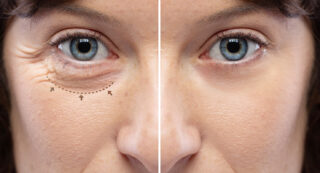
NewView Laser Eye, Inc.
12110 Sunset Hills Road
Suite 50
Reston, VA 20190
NewView Laser Eye, Inc.
20 Davis Ave SW
Leesburg, VA 20175

More Vision & Eye Care Articles
Blepharoplasty

As we age, the delicate skin around the eyes can appear puffy or saggy. Eyelid skin stretches, muscles weaken, and the normal deposits of protective fat around the eye bulge. The surgical procedure to remove excess eyelid tissues (skin, muscle, or fat) is called blepharoplasty.
Blepharoplasty can be performed on the upper eyelid, lower eyelid, or both. The surgery is performed for either cosmetic or functional reasons. Sometimes excess upper eyelid tissue obstructs the upper visual field or can weigh down the eyelid and produce tired-feeling eyes. Most often, people choose blepharoplasty to improve their appearance by making the area around their eyes firmer. When blepharoplasty is performed to improve vision, rather than for cosmetic reasons only, it may be covered by insurance.
Blepharoplasty for the lower lid removes the large bags under the eyes. It is unusual for third party payers to cover lower lid blepharoplasty.
The surgery is usually performed on an outpatient basis and can take one to three hours. Upper lid incisions are made in the natural crease of the lid, and lower lid incisions are made just below the lash line. A procedure for lower lid blepharoplasty, called transconjunctival blepharoplasty, removes excess fat through an incision inside the lower lid. Incisions are closed with fine sutures.
Swelling, bruising and blurry vision are common after blepharoplasty. Stitches are removed three to five days after surgery, except in the case of transconjunctival blepharoplasty where the self-dissolving sutures require no removal.
Possible complications associated with blepharoplasty include bleeding and swelling, delayed healing, infection, drooping of upper or lower eyelid, asymmetry, double vision, and dry eye. It is important to note that the puffiness of the fat pockets may not return, but normal wrinkling and aging of the eye area will continue.
Other Articles You May Find of Interest...
- Dry Eye Relief Is In Sight With Optilight
- iDesign Advanced WaveScan Studio
- Norcross Vision Innovators: Glaucoma and Cataract Solutions
- Exploring the Benefits Of Intense Pulsed Light (IPL) For Ocular Surface Health
- Lose Years Off Your Face In Just One Hour
- How to Find a Great Online Shop Offering Same Day Glasses Shipping: Your Quick Guide
- March Is Workplace Eye Wellness Month

















